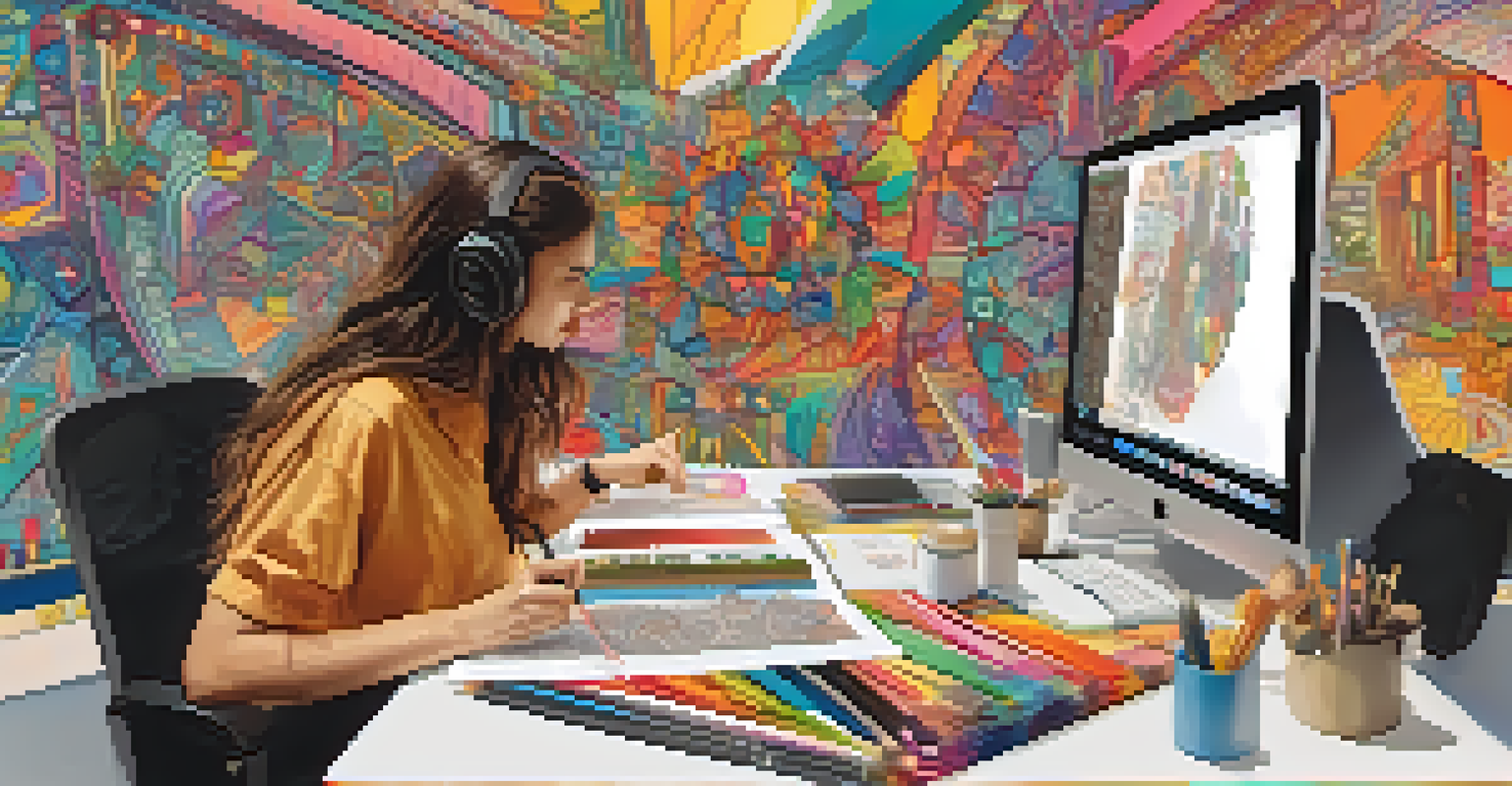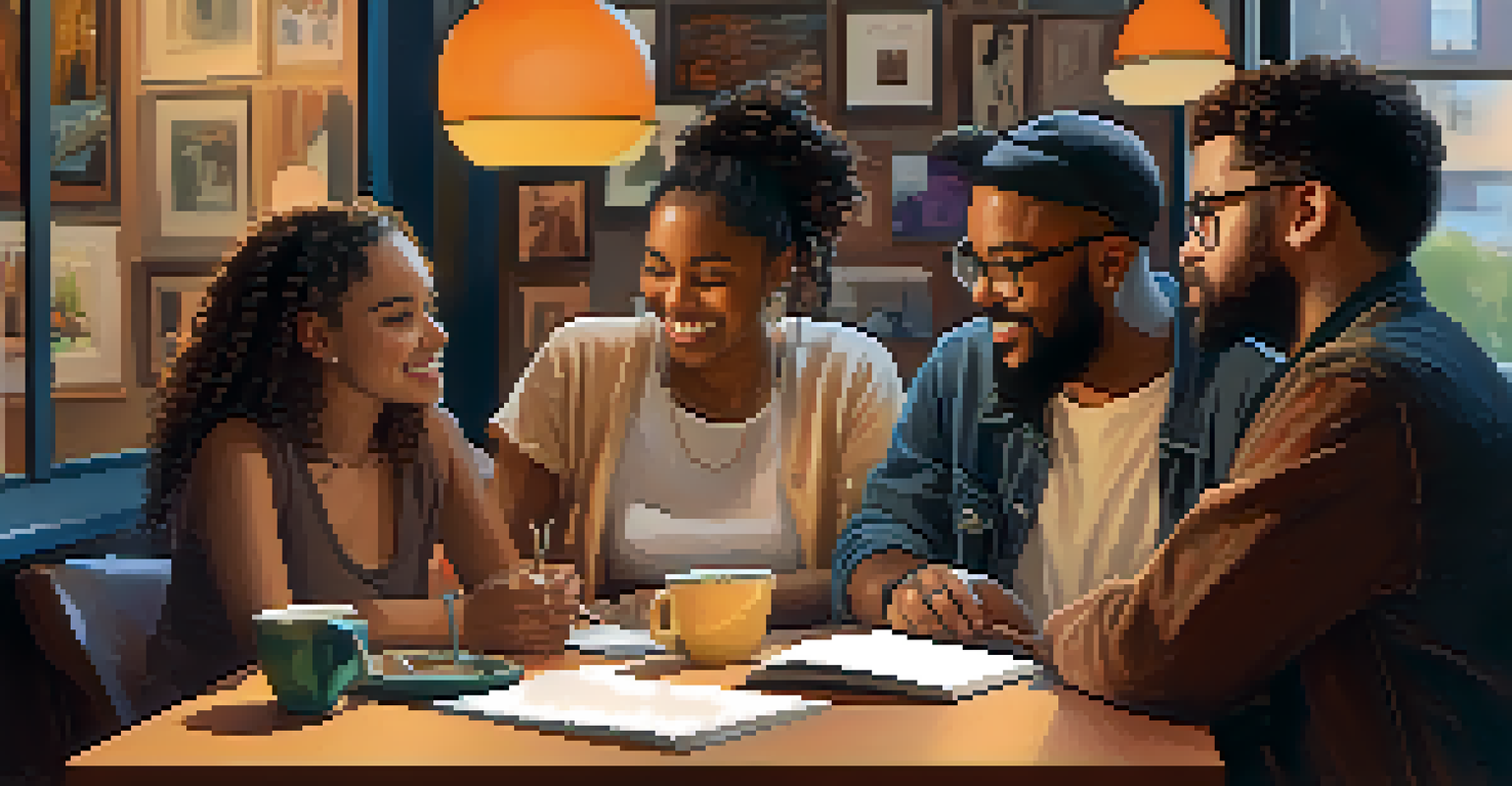Artistic Collaboration: The Power of Social Media

Understanding the Essence of Artistic Collaboration
Artistic collaboration is more than just working together; it’s about blending different perspectives to create something unique. Imagine a painter teaming up with a musician, where the colors of the artwork inspire the rhythm of the music. This synergy often leads to innovative creations that neither artist could achieve alone.
Creativity is intelligence having fun.
Social media has become a vital tool in facilitating these collaborations. Platforms like Instagram and TikTok allow artists to showcase their work, connect with others, and spark ideas. This interconnectedness fosters an environment where creativity can flourish, breaking down geographical barriers that once limited collaboration.
Ultimately, artistic collaboration reflects the diversity of human experience. It invites artists to share their stories and techniques, enriching the cultural tapestry we all contribute to. In this digital age, social media acts as a bridge, enabling artists to engage and inspire each other in ways never before possible.
Social Media: A Platform for Connection
Social media platforms serve as dynamic spaces where artists can find like-minded individuals. For instance, a photographer can easily connect with a graphic designer through a shared hashtag or a mutual friend. This ease of connection is invaluable in cultivating partnerships that might not occur in traditional settings.

Moreover, the global nature of social media means artists can collaborate with others from different cultures and backgrounds. This exposure can lead to rich, cross-cultural projects that enhance creativity and broaden artistic horizons. By sharing their unique experiences and techniques, artists can learn from each other and create something truly original.
Artistic Collaboration Unlocks Creativity
Blending diverse perspectives through collaboration leads to innovative creations that celebrate the richness of human experience.
Additionally, social media acts as a portfolio, allowing artists to showcase their work and attract potential collaborators. This visibility not only helps in finding partners but also in building a supportive community that celebrates and elevates each other's talents. Connections formed online can blossom into meaningful collaborations that transcend borders.
Case Studies of Successful Artistic Collaborations
There are numerous examples of successful artistic collaborations that began on social media. For instance, the viral project 'The 100 Day Project' encourages participants to create something new every day for 100 days, inspiring countless artists to share their creative journeys. Many participants end up collaborating, resulting in breathtaking works that highlight their individual styles.
The best way to predict the future is to create it.
Another notable example is the collaboration between street artists and musicians, which often emerges through social media interactions. Artists like Banksy have used platforms to connect with musicians, leading to the creation of murals that reflect the themes of their music. These projects not only amplify the artists' messages but create a dialogue between different art forms.
These case studies illustrate how social media can catalyze artistic partnerships, enabling artists to push boundaries and explore new ideas. The collaborative spirit fostered by these platforms encourages experimentation, leading to innovative works that captivate audiences and celebrate creativity.
The Role of Hashtags in Artistic Collaboration
Hashtags play a significant role in connecting artists within the vast landscape of social media. By using specific hashtags, artists can categorize their work and make it more discoverable. For instance, a painter using #ArtCollab can attract musicians, illustrators, and other artists interested in collaboration, making it easier to find potential partners.
Furthermore, trending hashtags often create a sense of community among artists. When individuals participate in collaborative challenges or themed projects, they share their work using the same hashtag, fostering interaction and engagement. This shared experience not only helps artists connect but also encourages a supportive atmosphere where feedback and encouragement flow freely.
Social Media Fosters Global Connections
Platforms like Instagram and TikTok enable artists to connect across cultures, enhancing creativity through cross-cultural projects.
Ultimately, hashtags are more than just labels; they are gateways to collaboration. By utilizing them effectively, artists can broaden their reach and engage with others who share their passion. In this way, hashtags contribute significantly to the collaborative process, enabling creativity to thrive in the digital age.
Social Media Challenges and Artistic Growth
While social media offers incredible opportunities for collaboration, it also presents challenges that can impact artistic growth. The pressure to maintain a constant online presence can lead to burnout, as artists may feel compelled to produce work primarily for likes and shares rather than personal satisfaction. This can detract from the authenticity of their artistic expression.
Moreover, the overwhelming nature of social media can make it difficult for artists to focus on their craft. With countless posts vying for attention, it’s easy to become distracted or discouraged. However, navigating these challenges can lead to personal growth, as artists learn to prioritize their creative vision over external validation.
By setting boundaries and engaging with social media mindfully, artists can harness its potential while protecting their artistic integrity. Embracing the journey of collaboration, rather than focusing solely on the outcome, can lead to more fulfilling and meaningful artistic experiences.
Building a Supportive Artistic Community Online
Creating a supportive artistic community online is crucial for fostering collaboration. Artists can engage with each other through comments, shares, and direct messages, creating meaningful connections that go beyond mere likes. By actively participating in discussions and offering constructive feedback, artists can build lasting relationships that enrich their creative journeys.
Moreover, social media allows artists to share not only their successes but also their struggles. This openness can inspire empathy and understanding within the community, encouraging others to share their experiences. When artists support one another, it creates an environment where creativity can flourish and collaborations can thrive.
Building Supportive Artistic Communities
Engaging with fellow artists online fosters meaningful connections and collective growth, creating a nurturing environment for collaboration.
Ultimately, a strong online community can serve as a source of motivation and inspiration. By uplifting each other, artists can navigate the challenges of their craft together, leading to more impactful collaborations and a shared celebration of creativity.
Looking Ahead: The Future of Artistic Collaboration
As technology continues to evolve, the future of artistic collaboration on social media looks promising. Emerging platforms and tools such as virtual reality and augmented reality are opening new avenues for artists to collaborate in exciting ways. Imagine musicians collaborating with visual artists to create immersive experiences that blend sound and visuals seamlessly.
Furthermore, the rise of decentralized platforms could allow artists to collaborate without the constraints of traditional social media algorithms. This shift could lead to more genuine interactions and opportunities for creative partnerships, empowering artists to connect on their own terms. The evolution of these platforms will likely reshape how we perceive and engage in artistic collaboration.

In conclusion, as we look ahead, it's clear that the power of social media will continue to play a vital role in fostering artistic collaboration. By embracing new technologies and nurturing supportive communities, artists can unlock their full potential and create innovative works that resonate across borders and generations.